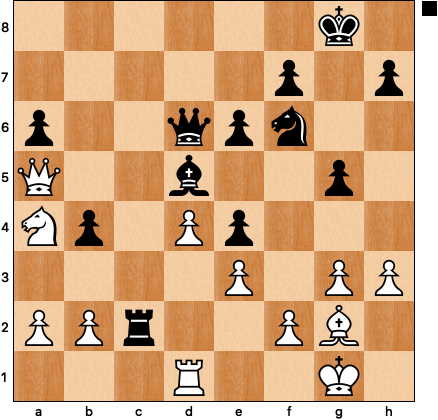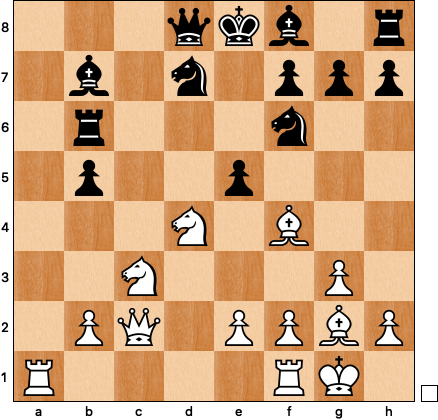I thought I had the perfect plan for in place for last weekend’s Sacramento Chess Championship: drive up Friday morning, play a couple games of chess while my wife and kids took the train up from the Bay Area. Take a bye Saturday morning and go with the family to the Sacramento railroad museum, then return for the evening round of the tournament. Take another bye in round five and visit some friends before playing the final round. With a little luck go 4-0 or 3.5-0.5, gain some rating points and win a prize.
The railroad museum and the visit with friends went off without a hitch, but the rest of the plan had some unforeseen flaws. Amtrak shut down the Sacramento line early Friday because of a suspicious package on the tracks, so I ended up driving back to the Bay Area Friday evening to fetch the family before driving us all right back up to Sacramento. I played rounds one, two, and four, but my opponent in round six failed to appear, so I finished the tournament with a disappointing forfeit victory1. Instead of two one-way drives between Sacramento and the Bay Area and four games of chess, I got four drives and three games. So it goes sometimes.
And as for the chess itself — well, there were some early warning signs that I might not be in good form. I like to warm up for a tournament by doing a bunch of tactics problems online because it’s the form of training that for me most closely approximates the rigors of tournament chess. I recently began doing an easier problem set on Chess Tempo because I could work quickly through more puzzles and the tactics felt more similar to situations I was encountering in games. It’s also a nice confidence boost to get ten or twenty puzzles correct in a row.
Not this time. A week or two before the tournament I missed 14 out of 18 easy problems, a stretch in which I missed obvious hanging pieces, moved without thinking, saw the winning continuation and then rejected it — basically anything and everything that could go wrong did go wrong. Something about my vision of the board felt off, the chess equivalent of looking for an item in the grocery store and not finding it even though it’s right in front of your face.
What is one to do when one has the calculation yips? Play solid, positional chess, trade the queens, take no risks. I tried to do that, but sometimes the siren call of tactics is too strong.
Round One: Serena Yuan - Andy Lee
In search of positional chess, I started the tournament with a boring symmetrical opening. However, by move eleven I was pretty sure that I had blundered a pawn:
My last move was Nf6-h5, a standard way of dealing with the annoying Bf4, and as I was admiring my handiwork, I suddenly realized that 12 Nxd5 exd5 13 Qxd5 forks my undefended knight and rook. When my opponent retreated her bishop I breathed a sigh of relief; not until after the tournament did I realize that 13 … Nxf4 14 Qxa8 Nxg2 is two pieces for the rook, not one.
Apparently part of the calculation yips is not being able to count the pieces — more on that later.
I pulled myself together and slowly gained control of the position, taking over first the c-file and then the seventh rank:
White’s last move was h2-h3 as she needs to keep the black knight out of g4. White’s army is for the moment badly uncoordinated and time is of the essence. I played 30 … Nh5 to prepare a sacrifice agains the kingside dark squares; for example, 31 Bf1 Rxf2! 32 Kxf2 Qxg3+ 33 Ke2 Bc4+ 34 Kd2 Qf2+ 35 Kc1 Qxe3+! (this is an important detail that I failed to notice during the game; if 35 … Bxf1 36 Qxg5+ is a problem) 36 Kb1 Bxf1 wins thanks to 37 Rxf1 Qd3+.
White played 31 g4, creating a new target: 31 … Nf62 32 Bf1 h5 33 gxh5 g4 (winning the g4 square for the knight is still the key to the position) 34 Qxa6 Qxa6 35 Bxa6 gxh3 36 a3 Ng4 (at last!) 37 Rf1:
Without the queens, down a pawn, black has complete control: 37 … h2+ 38 Kh1 (38 Kg2 Nxe3+) 38 … b3, and although I made life a little difficult for myself later on, the win was never really in doubt.
Round Two: Andy Lee - Ethan Liang
My plan for the tournament involved playing one game a day as much as possible3; if I could make in through the second round unscathed I was pretty much home free. Unfortunately, that was not to be, although for a moment it looked like I was going to win in style:
My opponent got tangled up in the process of evacuating the long diagonal, and I felt like I should have some way to take advantage. My crude solution 11 dxc5 Bxc5 12 b4 failed to 12 … Bd6, so I chose 11 a4 as a subtle method of improving the position. Now a4-a5 is a threat in some positions, but so is axb5 to soften up the queenside pawns and open the a-file. I couldn’t figure out a way to refute 11 … Bb7 with 12 a5, so I played 12 axb5 axb5 13 Nc3 instead, allowing black to win material: 13 … cxd4 14 Nxd4 e5:
I couldn’t believe that black could get away with this, and if he had traded first on g2 I was all set to play Ncxb5 and Nc7+ to finish off his king. But he left the bishops on the board, so rather than play what I had planned, I decided that 15 Bxb7 was the “safer” option. I simply hadn’t been able to find a knockout blow after 15 Ncxb5 exd4 (15 … exf4 16 Nc7+ Ke7 17 Nf5#) 16 Nc7+ Ke7:
On the one hand, it’s nice to see the entire winning variation ahead of time, on the other hand it’s really not necessary as long as you can visualize the position in the diagram. Black’s up a piece but actually he’s down a rook because the kingside pieces are as likely to move as the Amtrak train my wife and kids were at that very moment stranded upon. I was annoyed that 17 Bxb7 Rxb7 18 Ra8 didn’t work, but 18 Qc6 does — it threatens mate on d6 and the Rb7, so black either resigns here or in a few more moves.
But I was lured by the promise of 17 … Rxb7 18 Nc6 Qc8 19 Nxe5, saving one piece only to lose another to 19 … b4:
The irony is that I calculated this variation correctly and assumed that I would have some kind of tactical resource — here, rather than in the position with black’s king on e7! This was exactly the kind of problem I was having with puzzles before the tournament: I would see the winning variation and reject it for something much worse.
It’s worth noting that white’s still better here. 20 Qb3 Nxe5 21 Bxe5 bxc3 22 Qa4+ followed by 23 Bxc3 makes it hard to untangle, but I chose 20 Qa4, incorrectly counting the defenders of d7. All black has to do now is take the piece, develop his bishop, and castle. He did so and the game soon ended.
Round 4: Roi Weiss - Andy Lee
I was operating at very low self-confidence by the time the fourth round rolled around. I couldn’t remember the last time I had miscounted the number of defenders, and I was worried that at any moment my brain might decide to shut down for the night. Fortunately a day at the railroad museum was less taxing than playing a round of chess. Even so, I continued to struggle to play the most critical moves, starting with this position4:
The theme of this Scotch Gambit is whether or not black can play c6-c5 and d5-d4 to unlock the light-squared bishop and take over the center. White had been valiantly trying to hold the pawns back, but his last move, Qd2-e2, finally allowed me to push forward. I decided to do so, knowing that I was allowing the following trick5: 16 … c5 17 Ne1 Rg6 18 Nxd5 Bxd5 19 c4:
I’ve got a counter-trick up my sleeve, actually two possible tricks. The first is 19 … Bxg2 20 Nxg2 (20 Rxd8 Bf3+ and wins) 20 … Qa8, which is preferable as it keeps the initiative. The second, which I played in the game, fixes my pawns, but white gets to centralize his queen and make some threats: 19 … Nd4 20 Bxd4 Bxg2 21 Nxg2 cxd4 22 Qe4 c5 23 f4:
I felt like I had to win the game all over again, and made some progress pushing white’s pieces backwards over the next half-dozen moves:
There’s no immediate knockout blow, but 29 … Rb3 would have been a good way to keep creeping into the position. Normally I would play this quickly, but my worries about my bad form demanded the lowest risk possible: 29 … Qxe2 30 Rfxe2.
To my horror I realized that I had no idea how to win from here. White is going to play Ne1-d3, securing his weakness on b2 and tying a black piece to defense of c5. After convincing myself that I didn’t have time to activate my king, I played 30 … g5 to open the position. I essentially had to win the game yet again, but the third time was the charm after all. I managed to activate my bishop and took over the position.
I returned home pretty much convinced that I’d played my worst tournament6 of the past twenty years, but despite a number of bad moves I also played pretty well at times. Sometimes you’ve got it, sometimes you don’t, but usually it’s a mixed bag, the experience of that comes with age lessened by fuzzy memory and calculation. That said, I’m starting another tournament tomorrow night. I did some tactics problems today and got all fourteen correct, so we’ll see if that means the elusive good form is going to make an appearance. At least it’s only one game a week.
If you’re ever tempted to abandon a tournament without telling the TD, just remember that your opponent might be a busy parent who is enjoying one of his few tournaments of the year. Every game counts!
After the game the computer mentioned that 31 … Ng3 is possible. I assumed that 32 fxg3 Qxg3 33 Qd8+ was a draw (it is), but black can instead play 32 … h5!! stopping the perpetual. The only way to defend g3, 33 Kh2, loses to 33 … h4. Incredible stuff.
Since the pandemic my record in the first (or only) game of the day is +16, -2, =2. My record in the second or, ugh, third game of the day is +3, -4, =2.
In case you’re curious, black’s rook arrived on g4 via b8 and b4.
I vaguely considered the much stronger 16 … Qa8 but I had waited so long for c6-c5 that I couldn’t resist.
Half-tournament, that is.
















Good luck tomorrow night — I'll be there for Rd 2!